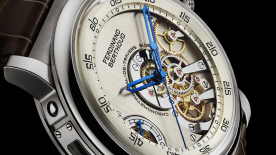Le Figaro - 15 April 2004
Pierre Maillard
On the brink of disappearing around the 1970s as a result of the quartz revolution, the Swiss watchmaking industry has succeeded in adjusting to the 21st century through its craftsmanship and marketing.
The definition of the word “manufactury” given by the Berner Dictionary of Horology, the industry reference book, immediately underlines its ambiguity. “In Swiss horology”, it reads, “the word manufactory designates factories which make watches almost entirely, as opposed to finishing workshops which are limited to winding, timing, fitting of hands and casing…”
One cannot help but smile when reading this vague “almost entirely” because the challenge of the manufactory lies entirely and precisely in this small space separating the almost from the entirely, a space that allows every interpretation, a gap into which all pretenders plummet. In the words of Philippe Stern, chairman of the family-run business Patek Philippe, without doubt the most rigorous Swiss manufactury, “we don't use the word manufactury as a marketing pitch as there is no definition of this term. It is too vague a concept “.
And who, moreover, could boast of having control “entirely”?
The question is not purely rhetorical. It could even have very serious and striking resonances. Because the word “manufactury” has an aura of prestige and antiquity to it, values that marketing men go wild for. The centuries-old prestige imparted by “manufactury” distinguishes you straight away. A “manufactury watch” has a pedigree which elevates it above run-of-the-mill watches. As its name suggests, a “manufactury watch” would (ideally) be made by an establishment which puts its heart into respecting the tradition of “fine workmanship” and where the hand is still every bit as important.
Candidates therefore jostle for this coveted title, generously bestowing its benefit on one another. “We have experienced a period in which everyone has sought to claim the title of manufactury, explains Jérôme Lambert, chairman of the Jaeger-LeCoultre manufactory. “But this trend which has engulfed Swiss horology is starting to retreat as most aspirants have realised that positioning themselves as such was costing them a fortune.”
It is true that everything is, or was, mixed up in this mêlée. And it is not always easy, even for a discerning consumer, to distinguish fable from historical fact or an almost empty shell from a watch movement entirely hand-crafted by a master watchmaker.
Let's try nevertheless to throw a little light on things.
“There are in fact several definitions of manufactory,” Jérôme Lambert once again confirms. “The structural definition is strict and is based on the vertical integration rate. The closer one gets to 100% control, the more one is a manufactory. All the elements of a watch should be designed, developed, produced and inspected, if possible under the same roof. Which is what we do at Jaeger-LeCoultre, except for the sapphire glass.”
Philippe Stern adds one more point: distribution. In his opinion, a manufactury must have “the capacity to research, develop and produce all its components and to distribute its products. It's a complete package which requires enormous experience and which is established in the long-term”.
Let us therefore be more exacting than Berner and try, as such, for fun, to describe a manufactury as only those firms capable of doing everything, or almost everything... Which narrows things down somewhat. Which of the most prestigious labels in fine watchmaking could still claim this title? Who is able to fully manufacture its own movements and its own exterior, its hands, its dial, even its sapphire glass or its straps and bracelets?
The answer is simple: no one! No one except, once again, the Swatch Group, taken as a whole. Thanks to its network of industrial plants, Nicolas Hayek's group has control over the manufacture of every component of a watch. And, above all, the Swatch Group alone has control over the manufacture at industrial level of a key element found at the heart of every movement: the famous balance spring. This very fine and metallurgically complex spring contains the energy delivered by its manual or automatic “winding” and redistributes it consistently and regularly in the form of oscillations to the balance. More than 90% of all mechanical watchmaking depends on deliveries of balance springs produced by the Swatch Group.
Only Rolex, which has just announced the merger of its two plants in Bienne and Geneva, comes close to boasting a comparable self-sufficiency.
All well and good. This is forgetting however that the first half of the word manufactury is derived from the ablative of the Latin for “hand”.
“I'm not running a manufactury but a watchmaking workshop “, states François-Paul Journe, often dubbed by his admirers in the profession as the “Breguet of the 21st century”. “I have no problem saying so because luxury watchmaking goes hand-in-hand, to my mind, with craftsmanship. Manufactory in the Swiss horology sector is a very industrial notion. It has lost its original sense of being hand-made.”
Let's award the hand this bonus, all the more readily since vertical integration is not always a guarantee of absolute quality. Even François-Paul Journe maintains that: “Ideally, a manufactury should be capable of doing almost everything but this isn't economically viable. And a non-specialist cannot manufacture all the components as perfectly as specialists do. The miniscule size of the components is the main difficulty encountered in watchmaking. It's quite simple: the only ones who are good at making gear trains, for example, are those who do that and nothing else. It could therefore be claimed that not only does the manufactury not exist but that it would be economically stupid for it to do so.”
As to the point about integration, at least, Journe agrees with Nicolas Hayek when the latter declares that “being a manufactory is not a question of exhaustiveness. It's not necessary to do everything, 100%, but a manufactury must without fail be capable of designing and controlling the exclusive production of its own movements. It is often forgotten that the movement is, so to speak, the loveliest and most sophisticated part of a luxury watch. Mastery of technique requires mastery of the art.”




